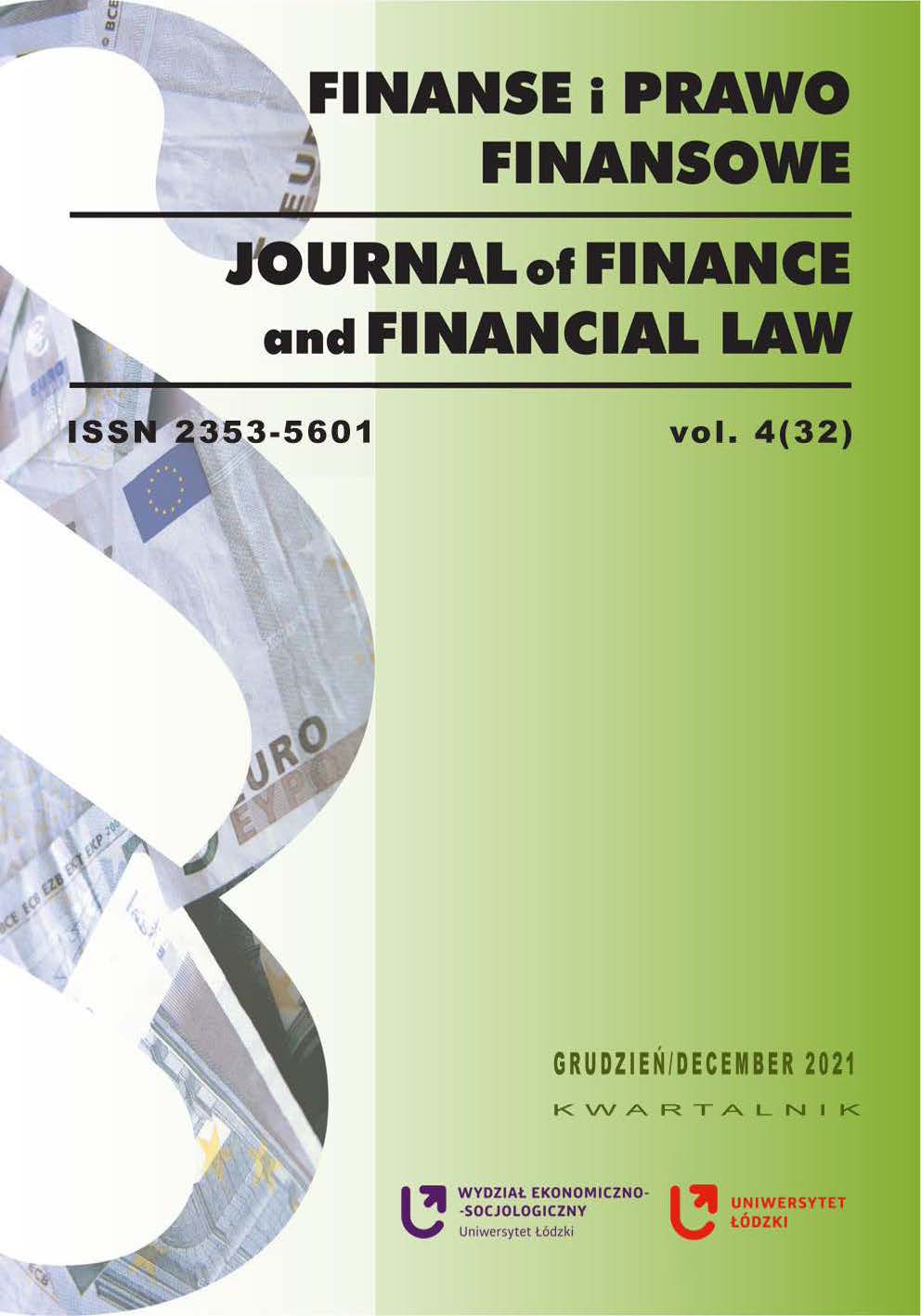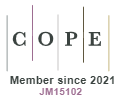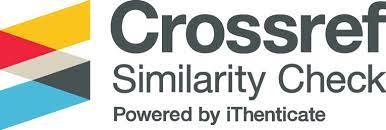Capital Structure of Companies Listed at the Warsaw Stock Exchange and the COVID-19 Pandemic Effect on Their Risk
DOI:
https://doi.org/10.18778/2391-6478.4.32.10Słowa kluczowe:
capital structure, COVID-19, company risk, capital market, stock exchangeAbstrakt
Subject: The financial management of companies is examined in the context of the COVID-19 pandemic. Specifically, the relationship between their capital structure and risk changes during the pandemic is scrutinised.
The purpose of the article: To determine how companies’ total, systematic and idiosyncratic risks changed during the COVID-19 pandemic depending on their capital structure based on a sample of organisations listed at the Warsaw Stock Exchange.
Methodology: The study involves the use of a panel data regression model.
Results of the research: The COVID-19 pandemic had an impact on the risk of overleveraged companies and underleveraged ones alike. Its influence on their total risk was weaker among the underleveraged organisations. Regarding systematic risk, its levels did not generally change significantly in the wake of the pandemic, but idiosyncratic risk, only in the case of the overleveraged companies increased statistically significantly.
Pobrania
Bibliografia
Ashraf, B.N. (2020). Stock markets’ reaction to COVID-19: Cases or fatalities? Research in International Business and Finance, 54(9), 101249.
Google Scholar
DOI: https://doi.org/10.1016/j.ribaf.2020.101249
Baker, M. and Wurgler, J. (2002). Market Timing and Capital Structure. The Journal of Finance, 57(1), pp. 1–32.
Google Scholar
DOI: https://doi.org/10.1111/1540-6261.00414
Black, F. (1976). Studies of stock price volatility changes. Proceedings of the 1976 meetings of the American Statistical Association, Business and Economic Statistics Section.
Google Scholar
Brennan, M.J. and Schwartz, E.S. (1978). Corporate income taxes, valuation, and the problem of optimal capital structure. Journal of Business, 51(1), pp. 103–114.
Google Scholar
DOI: https://doi.org/10.1086/295987
Chodnicka-Jaworska, P. and Jaworski, P. (2020). Wrażliwość rynku akcji na publikacje danych rynkowych w czasie pandemii COVID-19. Warszawa: Wydawnictwo Naukowe Wydziału Zarządzania Uniwersytetu Warszawskiego.
Google Scholar
DOI: https://doi.org/10.7172/978-83-66282-21-6.2020.wwz.3
Christie, A.A. (1982). The stochastic behavior of common stock variances: value, leverage and interest rate effects. Journal of Financial Economics, 10, pp. 407–432.
Google Scholar
DOI: https://doi.org/10.1016/0304-405X(82)90018-6
Croce, M., Farroni, P. and Wolfskeil, I. (2020). When the markets get COVID: Contagion, viruses, and information diffusion. CEPR Discussion Papers, 14674.
Google Scholar
DOI: https://doi.org/10.2139/ssrn.3560347
Damodaran, A. (2001). Corporate Finance, Theory and Practice. New York: John Wiley and Sons.
Google Scholar
Fahlenbrach, R., Rageth, K. and Stulz, R.M. (2020). How valuable is financial flexibility when revenue stops? Evidence from the COVID-19 crisis. NBER Working paper, 27106.
Google Scholar
DOI: https://doi.org/10.3386/w27106
Favara, G., Schroth, E. and Valta, P. (2012). Strategic default and equity risk across countries. The Journal of Finance, 67, pp. 2051–2095.
Google Scholar
DOI: https://doi.org/10.1111/j.1540-6261.2012.01781.x
Gajdka, J. and Szymański, M. (2020). COVID-19 a polski rynek kapitałowy – czy wyniki finansowe spółek uzasadniają zmiany cen akcji na Giełdzie Papierów Wartościowych w Warszawie? Przedsiębiorczość i Zarządzanie, XXI (4), pp. 35–52.
Google Scholar
Gordon, M.J. (1962). The investment, financing, and valuation of the corporation. RD IRWIN.
Google Scholar
DOI: https://doi.org/10.2307/1926621
Halling, M., Jin, Y. and Zechner, J. (2020). How did COVID-19 affect firms’ access to public capital markets? Review of Corporate Finance Studies, 9, pp. 501–533.
Google Scholar
DOI: https://doi.org/10.1093/rcfs/cfaa008
Huang, H. and Ye, Y. (2021). Rethinking capital structure decision and corporate social responsibility in response to COVID-19. Accounting & Finance, 61, pp. 4757–4788.
Google Scholar
DOI: https://doi.org/10.1111/acfi.12740
Iyke, B.N. (2020). COVID-19: The reaction of US oil and gas producers to the pandemic. Energy Research Letters, 1(2), 1–7.
Google Scholar
DOI: https://doi.org/10.46557/001c.13912
Jaworski, P. (2021). Wpływ pandemii COVID-19 na główne indeksy giełdowe na świecie. Zarządzanie Mediami, 9(1), pp. 157–172.
Google Scholar
DOI: https://doi.org/10.4467/23540214ZM.21.010.13057
Jensen, M.C. (1986). Agency costs of free cash flow, corporate finance, and takeovers. American Economic Review, 76, pp. 323–329.
Google Scholar
Kesten, J.B. (2010). Managerial entrenchment and shareholder wealth revisited: theory and evidence from a recessionary financial marke. Brigham Young University Law Review, 5, pp. 1609–1660.
Google Scholar
DOI: https://doi.org/10.2139/ssrn.1555856
Kraus, A. and Litzenberger, R.H. (1973). A state-preference model of optimal financial Leverage. Journal of Finance, 28, pp. 911–922.
Google Scholar
DOI: https://doi.org/10.1111/j.1540-6261.1973.tb01415.x
Li, L., Strahan, P.E. and Zhang, S. (2020). Banks as lenders of first resort: evidence from the COVID-19 crisis. Review of Corporate Finance Studies, 9, pp. 472–500.
Google Scholar
DOI: https://doi.org/10.1093/rcfs/cfaa009
Liu, L., Wang, E.Z. and Lee, C.C. (2020). Impact of the COVID-19 pandemic on the crude oil and stock markets in the US: A time-varying analysis. Energy Research Letters, 1(1), p. 1315.
Google Scholar
DOI: https://doi.org/10.46557/001c.13154
Machica, M., and Mura, R. (2010). Financial flexibility, investment ability, and firm value: evidence from firms with spare debt capacity. Financial Management, 10, pp. 1339–1365.
Google Scholar
DOI: https://doi.org/10.1111/j.1755-053X.2010.01115.x
Modigliani, F. and Miller, M.H. (1958). The cost of capital, corporation finance and the theory of investment. The American Economic Review, 48, pp. 261–297.
Google Scholar
Modigliani, F. and Miller, M.H. (1963). Corporate Income Taxes and the Cost of Capital A Correction. American Economic Review, 53, pp. 433–443.
Google Scholar
Murawska, M. (2020). Pandemia COVID-19 jako czynnik egzogeniczny zmian wartości przedsiębiorstw – główne światowe indeksy giełdowe w pierwszym kwartale 2020 roku. Nowoczesne Systemy Zarządzania Instytut Organizacji i Zarządzania,15(4), pp. 79–93.
Google Scholar
DOI: https://doi.org/10.37055/nsz/134106
Myers, S.C. and Majluf N.S. (1984). Corporate financing and investment decisions When firms have information that inivestors do not have. Journal of Financial Economics, 13(2), pp. 187–221.
Google Scholar
DOI: https://doi.org/10.1016/0304-405X(84)90023-0
Reilly, J. (2020). Treatment considerations for coronavirus (COVID-19). Hospital Practice, 84(3), pp. 119–120.
Google Scholar
DOI: https://doi.org/10.1080/21548331.2020.1754618
Rudnicki, K. (2017). W poszukiwaniu metody wyznaczania optymalnej struktury kapitałowej. Annales Universitatis Mariae Curie-Skłodowska Lublin-Polonia, LI, 6 Sectio H, pp. 367–375.
Google Scholar
DOI: https://doi.org/10.17951/h.2017.51.6.367
Saadat, S., Rawtani, D. and Hussain, C.M. (2020). Environmental perspective of COVID-19. Science of the Total Environment, 728, pp. 138−870.
Google Scholar
DOI: https://doi.org/10.1016/j.scitotenv.2020.138870
Schwert, G.W. (1989). Why does stock market volatility change over time? Journal of Finance, 44, pp. 1115–1153.
Google Scholar
DOI: https://doi.org/10.1111/j.1540-6261.1989.tb02647.x
Sharpe, W.F. (1964). Capital asset prices: a theory of market equilibrium under conditions of risk. Journal of Finance, 19, pp. 425–442.
Google Scholar
DOI: https://doi.org/10.1111/j.1540-6261.1964.tb02865.x
Shyam-Sunder, L. and Myers, S.C. (1999). Testing static tradeoff against pecking order models of capital structure. Journal of Financial Economics, 51(2), pp. 219–244.
Google Scholar
DOI: https://doi.org/10.1016/S0304-405X(98)00051-8
Solomon, E. (1963). The Theory of Financial Management. Columbia University Press.
Google Scholar
Yan, C. (2020). COVID-19 Outbreak and Stock Prices: Evidence from China. SSRN Working Paper, 7.
Google Scholar
DOI: https://doi.org/10.2139/ssrn.3574374
Zbawienny wpływ COVID-19. Prezes GPW o rynku kapitałowym w czasie pandemii (2021). Business Insider Polska PAP, 08 wrzesień 2021, https://businessinsider.com.pl/gielda/wiadomosci/zbawienny-wplyw-covid-19-prezes-gpw-marek-dietl-o-rynku-kapitalowym-w-czasie-pandemii/h38p412 [Accessed 19.10.2021].
Google Scholar
Pobrania
Opublikowane
Jak cytować
Numer
Dział
Licencja

Utwór dostępny jest na licencji Creative Commons Uznanie autorstwa – Użycie niekomercyjne – Bez utworów zależnych 4.0 Międzynarodowe.














